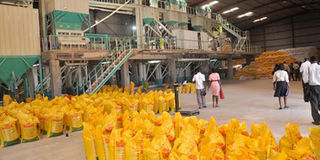EALA MP, activists ask regional states to cut wheat, rice imports

Imported rice ready for processing at the FOL logistics warehouse in Namanve, Mukono District where Kingdom Rice is processed. FILE PHOTO
What you need to know:
- Mr Audax Rukonge, the Agricultural Non-state actors’ forum, a Tanzanian based organisation said the region should impose high tariffs on every food imports to stimulate both production and productivity of those food varieties that are being imported.
- The sector contribution to the regional GDP is however consistently declining in performance and actual value.
NAIROBI: The East African Legislative Assembly (EALA), has asked regional states to reduce wheat and rice imports and instead facilitate small scale farmers to produce the said crops for the region and export.
Terming the current imports of wheat and rice as “shaming and a recipe for re-colonisation,” Mr Mathias Kasamba, Uganda’s EALA representative who doubles as chair of the regional body’s committee on agriculture, tourism and natural resources, said food imports should be tackled urgently.
“We are being re-colonised; this time by food imports. The more we import, the more we are giving out our jobs, and the more we are dependent on others countries to feed our growing population,” Mr Kasamba said in the Kenyan capital Nairobi at East African farmers’ summit.
The summit run under the theme: “Promoting an Inclusive, People Centred EAC Budget Process: Incentives for Prudent Public and Private Investment in Agriculture” and farmers and farmers’ organisations presented their grievances to EALA Parliament. It was supported by ActionAid among other organisations.
“The money being used to import wheat or rice should be used to help our farmers produce locally. There are currently high rice and wheat yielding varieties that our governments can promote to increase production,” he added.
Available figures indicate that Uganda imports 95 per cent of wheat for food, which costs up to $121m annually. The country, the National Agricultural Research Organisation scientists say, has potential to produce wheat in West Nile, Mt Elgon, in the south-west and parts of northern region.
Kenya imports two-thirds of wheat imports to meet the annual consumption of 900,000 tonnes against the local production of 350,000. Other EAC member states also import large quantities of the rice and wheat imports.
Ms Agnes Kirabo, the executive director of Food Rights Alliance, a civil society organisation in Uganda said none of the EAC members have committed to 10 per cent of their budget to the agriculture sector and the result has been millions of citizens going hungry, suffering from malnutrition and poverty.
“Food imports are increasing to meet food needs and this curtails the transformation of the sector [agricultural] and development. We need to support our local farmers to produce” Ms Kirabo said.
She added that there is little intra-trade among the EAC that would guarantee good prices whenever there is over supply in some countries.
Mr Audax Rukonge, the Agricultural Non-state actors’ forum, a Tanzanian based organisation said the region should impose high tariffs on every food imports to stimulate both production and productivity of those food varieties that are being imported.
“Why do we continue to import these things [food] yet we are producing them here? I know importing a choice but we can high tariffs on those imports,” Mr Rukonge said.
Mr Jean Baptiste Havugimana, the EAC director productive sectors said: “Why should we import maize from Mexico yet Uganda has? Why should we import wheat yet Tanzania is producing or matooke yet Uganda and Rwanda are producing them?”
East Africa is largely rural based and natural resource dependent, with about 80 per cent residents deriving their livelihoods from agriculture.
The sector contribution to the regional GDP is however consistently declining in performance and actual value. In 2015, the sector contribution to GDP declined by 34 per cent in Burundi, 29 per cent in Kenya, 32 per cent in Rwanda, 25 per cent in Tanzania and 23 per cent in Uganda. This sort of decline reflects high poverty levels in the region that were reported at 46.6 per cent.




